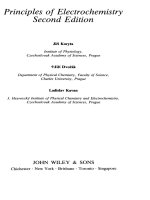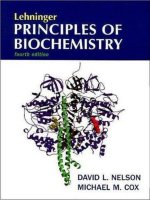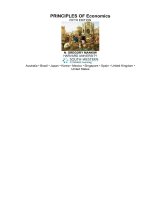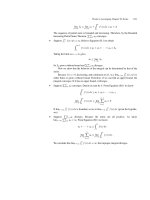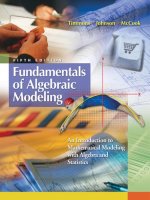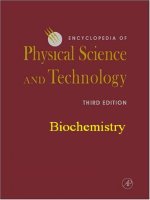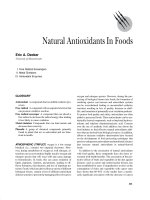Principles of biochemistry 5th edition Part 1
Bạn đang xem bản rút gọn của tài liệu. Xem và tải ngay bản đầy đủ của tài liệu tại đây (25.66 MB, 320 trang )
This page intentionally left blank
Principles of Biochemistry
This page intentionally left blank
Principles of Biochemistry
Fifth Edition
Laurence A. Moran
University of Toronto
H. Robert Horton
North Carolina State University
K. Gray Scrimgeour
University of Toronto
Marc D. Perry
University of Toronto
Boston Columbus Indianapolis New York San Francisco Upper Saddle River
Amsterdam Cape Town Dubai London Madrid Milan Munich Paris Montreál Toronto
Delhi Mexico City Sao Pauló Sydney Hong Kong Seoul Singapore Taipei Tokyo
Editor in Chief: Adam Jaworski
Executive Editor: Jeanne Zalesky
Marketing Manager: Erin Gardner
Project Editor: Jennifer Hart
Associate Editor: Jessica Neumann
Editorial Assistant: Lisa Tarabokjia
Marketing Assistant: Nicola Houston
Vice President, Executive Director of Development: Carol Truehart
Developmental Editor: Michael Sypes
Managing Editor, Chemistry and Geosciences: Gina M. Cheselka
Project Manager, Science: Wendy Perez
Senior Technical Art Specialist: Connie Long
Art Studios: Mark Landis Illustrations
/Jonathan Parrish
/2064 Design—Greg Gambino
Image Resource Manager: Maya Melenchuk
Photo Researcher: Eric Schrader
Art Manager: Marilyn Perry
Interior/Cover Designer: Tamara Newnam
Media Project Manager: Shannon Kong
Senior Manufacturing and Operations Manager: Nick Sklitsis
Operations Specialist: Maura Zaldivar
Composition/Full Service: Nesbitt Graphics, Inc.
Cover Illustration: Quade Paul, Echo Medical Media
Cover Image Credit: Monkey adapted from Simone van den Berg/Shutterstock
Credits and acknowledgments borrowed from other sources and reproduced, with permission, in this textbook
appear on page 767.
Copyright ©2012, 2006, 2002, 1996 Pearson Education, Inc., All rights reserved. Manufactured in the United
States of America. This publication is protected by Copyright and permission should be obtained from the
publisher prior to any prohibited reproduction, storage in a retrieval system, or transmission in any form or by
any means, electronic, mechanical, photocopying, recording, or likewise. To obtain permission(s) to use material
from this work, please submit a written request to Pearson Education, Inc., Permissions Department,
1900 E. Lake Ave., Glenview, IL 60025. For information regarding permissions, call (847) 486-2635.
Many of the designations used by manufacturers and sellers to distinguish their products are claimed as
trademarks. Where those designations appear in this book, and the publisher was aware of a trademark claim, the
designations have been printed in initial caps or all caps.
Library of Congress Cataloging-in-Publication Data
Principles of biochemistry / H. Robert Horton ... [et al]. — 5th ed.
p. cm.
ISBN 0-321-70733-8
1. Biochemistry. I. Horton, H. Robert, 1935QP514.2.P745 2012
612'.015—dc23
2011019987
ISBN 10:
0-321-70733-8
ISBN 13: 978-0-321-70733-8
1 2 3 4 5 6 7 8 9 10—DOW—16 15 14 13 12
Science should be as simple as possible,
but not simpler.
– Albert Einstein
This page intentionally left blank
Brief Contents
Part One
Introduction
1 Introduction to Biochemistry
2 Water 28
1
Part Two
Structure and Function
3
4
5
6
7
8
9
Amino Acids and the Primary Structures of Proteins
55
Proteins: Three-Dimensional Structure and Function
85
Properties of Enzymes
134
Mechanisms of Enzymes
162
Coenzymes and Vitamins
196
Carbohydrates
227
Lipids and Membranes
256
Part Three
Metabolism and Bioenergetics
10 Introduction to Metabolism 294
11 Glycolysis 325
12 Gluconeogenesis, the Pentose Phosphate
Pathway, and Glycogen Metabolism
13
14
15
16
17
18
The Citric Acid Cycle
355
385
Electron Transport and ATP Synthesis
Photosynthesis
417
443
Lipid Metabolism
475
Amino Acid Metabolism
Nucleotide Metabolism
514
550
Part Four
Biological Information Flow
19
20
21
22
Nucleic Acids
573
DNA Replication, Repair, and Recombination
Transcription and RNA Processing
Protein Synthesis
601
634
666
vii
Contents
To the Student
Preface
xxiii
xxv
About the Authors
xxxiii
Part One
Introduction
1
Introduction to Biochemistry
1.1
Biochemistry Is a Modern Science
1.2
The Chemical Elements of Life
1.3
Many Important Macromolecules Are Polymers
A. Proteins
6
B. Polysaccharides
C. Nucleic Acids
2
3
4
6
7
D. Lipids and Membranes
1.4
1
9
The Energetics of Life
10
A. Reaction Rates and Equilibria
B. Thermodynamics
11
12
C. Equilibrium Constants and Standard Gibbs Free Energy Changes
D. Gibbs Free Energy and Reaction Rates
1.5
Biochemistry and Evolution
1.6
The Cell Is the Basic Unit of Life
1.7
Prokaryotic Cells: Structural Features
1.8
Eukaryotic Cells: Structural Features
A. The Nucleus
20
14
15
17
17
18
B. The Endoplasmic Reticulum and Golgi Apparatus
C. Mitochondria and Chloroplasts
D. Specialized Vesicles
E. The Cytoskeleton
1.9
21
22
23
A Picture of the Living Cell
23
1.10 Biochemistry Is Multidisciplinary
26
Appendix: The Special Terminology of Biochemistry
Selected Readings
Water
2.1
The Water Molecule Is Polar
28
Hydrogen Bonding in Water
Box 2.1 Extreme Thermophiles
2.3
29
30
32
Water Is an Excellent Solvent
32
A. Ionic and Polar Substances Dissolve in Water
Box 2.2 Blood Plasma and Seawater
33
B. Cellular Concentrations and Diffusion
C. Osmotic Pressure
viii
2.4
26
27
2
2.2
20
34
34
Nonpolar Substances Are Insoluble in Water
35
32
13
CONTENTS
2.5
Noncovalent Interactions
37
A. Charge–Charge Interactions
B. Hydrogen Bonds
37
37
C. Van der Waals Forces
38
D. Hydrophobic Interactions
2.6
Water Is Nucleophilic
39
39
Box 2.3 The Concentration of Water
41
2.7
Ionization of Water
2.8
The pH Scale
43
Box 2.4 The Little “p” in pH
2.9
Acid Dissociation Constants of Weak Acids
44
Sample Calculation 2.1 Calculating the pH of Weak Acid Solutions
41
44
2.10 Buffered Solutions Resist Changes in pH
Sample Calculation 2.2 Buffer Preparation
Summary
52
Problems
52
Selected Readings
49
50
50
54
PART TWO
Structure and Function
3
Amino Acids and the Primary Structures of Proteins
3.1
General Structure of Amino Acids
3.2
56
Structures of the 20 Common Amino Acids
58
Box 3.1 Fossil Dating by Amino Acid Racemization
A. Aliphatic R Groups
59
B. Aromatic R Groups
59
C. R Groups Containing Sulfur
58
60
D. Side Chains with Alcohol Groups
60
Box 3.2 An Alternative Nomenclature
61
E. Positively Charged R Groups
61
F. Negatively Charged R Groups and Their Amide Derivatives
G. The Hydrophobicity of Amino Acid Side Chains
3.3
Other Amino Acids and Amino Acid Derivatives
3.4
Ionization of Amino Acids
63
Box 3.3 Common Names of Amino Acids
3.5
Peptide Bonds Link Amino Acids in Proteins
3.6
Protein Purification Techniques
3.7
Analytical Techniques
3.8
Amino Acid Composition of Proteins
3.9
Determining the Sequence of Amino Acid Residues
62
62
62
64
67
68
70
3.10 Protein Sequencing Strategies
73
74
76
3.11 Comparisons of the Primary Structures of
Proteins Reveal Evolutionary Relationships
Summary
82
Problems
55
79
82
Selected Readings
84
4
Proteins: Three-Dimensional Structure and Function
4.1
There Are Four Levels of Protein Structure
87
4.2
Methods for Determining Protein Structure
88
85
ix
x
CONTENTS
4.3
The Conformation of the Peptide Group
91
Box 4.1 Flowering Is Controlled by Cis/Trans Switches
4.4
The a Helix
4.5
b Strands and b Sheets
4.6
Loops and Turns
4.7
Tertiary Structure of Proteins
99
A. Supersecondary Structures
100
B. Domains
93
94
97
98
101
C. Domain Structure, Function, and Evolution
D. Intrinsically Disordered Proteins
4.8
Quaternary Structure
4.9
Protein–Protein Interactions
102
102
103
109
4.10 Protein Denaturation and Renaturation
110
4.11 Protein Folding and Stability
114
A. The Hydrophobic Effect
114
B. Hydrogen Bonding
115
Box 4.2 CASP: The Protein Folding Game
116
C. Van der Waals Interactions and Charge–Charge Interactions
D. Protein Folding Is Assisted by Molecular Chaperones
4.12 Collagen, a Fibrous Protein
Box 4.3 Stronger Than Steel
119
121
4.13 Structure of Myoglobin and Hemoglobin
122
4.14 Oxygen Binding to Myoglobin and Hemoglobin
A. Oxygen Binds Reversibly to Heme
123
123
B. Oxygen-Binding Curves of Myoglobin and Hemoglobin
Box 4.4 Embryonic and Fetal Hemoglobins
C. Hemoglobin Is an Allosteric Protein
4.15 Antibodies Bind Specific Antigens
Summary
130
Problems
5.1
129
133
Properties of Enzymes
The Six Classes of Enzymes
134
136
C. The Meanings of Km
5.5
138
139
The Michaelis-Menten Equation
140
A. Derivation of the Michaelis-Menten Equation
B. The Calalytic Constant Kcat
5.4
137
Kinetic Experiments Reveal Enzyme Properties
A. Chemical Kinetics
138
B. Enzyme Kinetics
5.3
126
127
Box 5.1 Enzyme Classification Numbers
5.2
124
131
Selected Readings
5
117
117
141
143
144
Kinetic Constants Indicate Enzyme Activity and Catalytic Proficiency
Measurement of Km and Vmax
145
Box 5.2 Hyperbolas Versus Straight Lines
5.6
Kinetics of Multisubstrate Reactions
5.7
Reversible Enzyme Inhibition
148
A. Competitive Inhibition
149
B. Uncompetitive Inhibition
150
147
146
144
CONTENTS
C. Noncompetitive Inhibition
150
D. Uses of Enzyme Inhibition
151
5.8
Irreversible Enzyme Inhibition
152
5.9
Regulation of Enzyme Activity
153
A. Phosphofructokinase Is an Allosteric Enzyme
B. General Properties of Allosteric Enzymes
C. Two Theories of Allosteric Regulation
154
155
156
D. Regulation by Covalent Modification
158
5.10 Multienzyme Complexes and Multifunctional Enzymes
Summary
159
Problems
159
Selected Readings
161
6
Mechanisms of Enzymes
6.1
The Terminology of Mechanistic Chemistry
A. Nucleophilic Substitutions
163
B. Cleavage Reactions
His-95
162
O
162
H2C
163
C. Oxidation–Reduction Reactions
164
Catalysts Stabilize Transition States
6.3
Chemical Modes of Enzymatic Catalysis
166
A. Polar Amino Acids Residues in Active Sites
164
166
Box 6.1 Site-Directed Mutagenesis Modifies Enzymes
B. Acid–Base Catalysis
C. Covalent Catalysis
168
169
D. pH Affects Enzymatic Rates
171
Box 6.2 The “Perfect Enzyme”?
174
B. Superoxide Dismutase
6.5
170
Diffusion-Controlled Reactions
A. Triose Phosphate Isomerase
172
175
Modes of Enzymatic Catalysis
175
A. The Proximity Effect
176
B. Weak Binding of Substrates to Enzymes
C. Induced Fit
6.6
180
Serine Proteases
183
A. Zymogens Are Inactive Enzyme Precursors
Box 6.3 Kornberg’s Ten Commandments
C. Serine Proteases Use Both the Chemical
and the Binding Modes of Catalysis
185
Box 6.4 Clean Clothes
186
Box 6.5 Convergent Evolution
Lysozyme
6.8
Arginine Kinase
Summary
192
Problems
187
190
193
Selected Readings
194
187
183
183
B. Substrate Specificity of Serine Proteases
6.7
178
179
D. Transition State Stabilization
C
CH 2
Glu-165
6.2
6.4
158
184
167
O
H
H
CH 2
OH
1
C
2
C
3
CH 2 OPO 3
H
O
2
N
N
xi
xii
CONTENTS
7
Coenzymes and Vitamins
7.1
Many Enzymes Require Inorganic Cations
7.2
Coenzyme Classification
7.3
197
197
ATP and Other Nucleotide Cosubstrates
Box 7.1 Missing Vitamins
7.4
196
198
200
NAD ᮍ and NADP ᮍ
200
Box 7.2 NAD Binding to Dehydrogenases
7.5
FAD and FMN
7.6
Coenzyme A and Acyl Carrier Protein
7.7
Thiamine Diphosphate
7.8
Pyridoxal Phosphate
7.9
Vitamin C
7.10 Biotin
203
204
204
206
207
209
211
Box 7.3 One Gene: One Enzyme
7.11 Tetrahydrofolate
212
213
7.12 Cobalamin
215
7.13 Lipoamide
216
7.14 Lipid Vitamins
A. Vitamin A
217
217
B. Vitamin D
218
C. Vitamin E
218
D. Vitamin K
218
7.15 Ubiquinone
219
Box 7.4 Rat Poison
220
7.16 Protein Coenzymes
221
7.17 Cytochromes
221
Box 7.5 Noble Prizes for Vitamins and Coenzymes
Summary
223
Problems
224
Selected Readings
226
8
Carbohydrates
8.1
Most Monosaccharides Are Chiral Compounds
8.2
Cyclization of Aldoses and Ketoses
8.3
Conformations of Monosaccharides
8.4
Derivatives of Monosaccharides
A. Sugar Phosphates
235
227
B. Deoxy Sugars
235
C. Amino Sugars
235
D. Sugar Alcohols
E. Sugar Acids
8.5
230
234
235
236
236
Disaccharides and Other Glycosides
236
A. Structures of Disaccharides
237
B. Reducing and Nonreducing Sugars
C. Nucleosides and Other Glycosides
Box 8.1 The Problem with Cats
8.6
Polysaccharides
240
A. Starch and Glycogen
B. Cellulose
223
243
240
240
238
239
228
CONTENTS
C. Chitin
8.7
244
Glycoconjugates
A. Proteoglycans
244
244
Box 8.2 Nodulation Factors Are Lipo-Oligosaccharides
B. Peptidoglycans
C. Glycoproteins
248
Box 8.3 ABO Blood Group
Summary
252
Problems
253
246
246
Selected Readings
250
254
9
Lipids and Membranes
9.1
Structural and Functional Diversity of Lipids
9.2
Fatty Acids
256
Box 9.1 Common Names of Fatty Acids
256
258
Box 9.2 Trans Fatty Acids and Margarine
9.3
Triacylglycerols
9.4
Glycerophospholipids
9.5
Sphingolipids
9.6
Steroids
9.7
Other Biologically Important Lipids
9.8
Biological Membranes
269
A. Lipid Bilayers
269
256
259
261
262
263
266
268
Box 9.3 Gregor Mendel and Gibberellins
270
B. Three Classes of Membrane Proteins
270
Box 9.4 New Lipid Vesicles, or Liposomes
272
Box 9.5 Some Species Have Unusual Lipids in Their Membranes
C. The Fluid Mosaic Model of Biological Membranes
9.9
Membranes Are Dynamic Structures
275
9.10 Membrane Transport
277
A. Thermodynamics of Membrane Transport
B. Pores and Channels
278
279
C. Passive Transport and Facilitated Diffusion
D. Active Transport
280
282
E. Endocytosis and Exocytosis
283
9.11 Transduction of Extracellular Signals
A. Receptors
283
Box 9.6 The Hot Spice of Chili Peppers
B. Signal Transducers
283
284
285
C. The Adenylyl Cyclase Signaling Pathway
287
D. The Inositol–Phospholipid Signaling Pathway
Box 9.7 Bacterial Toxins and G Proteins
E. Receptor Tyrosine Kinases
Summary
291
Problems
292
Selected Readings
293
290
290
287
274
274
xiii
xiv
CONTENTS
PART THREE
Metabolism and Bioenergetics
10 Introduction to Metabolism
10.1 Metabolism Is a Network of Reactions
294
294
10.2 Metabolic Pathways
297
A. Pathways Are Sequences of Reactions
297
B. Metabolism Proceeds by Discrete Steps
C. Metabolic Pathways Are Regulated
D. Evolution of Metabolic Pathways
10.3 Major Pathways in Cells
297
297
301
302
10.4 Compartmentation and Interorgan Metabolism
304
10.5 Actual Gibbs Free Energy Change, Not Standard Free Energy Change,
Determines the Direction of Metabolic Reactions
306
Sample Calculation 10.1 Calculating Standard Gibbs Free Energy
Change from Energies of Formation
308
10.6 The Free Energy of ATP Hydrolysis
308
10.7 The Metabolic Roles of ATP
311
A. Phosphoryl Group Transfer
311
Sample Calculation 10.2 Gibbs Free Energy Change
Box 10.1 The Squiggle
312
312
B. Production of ATP by Phosphoryl Group Transfer
C. Nucleotidyl Group Transfer
314
315
10.8 Thioesters Have High Free Energies of Hydrolysis
316
10.9 Reduced Coenzymes Conserve Energy from Biological Oxidations
A. Gibbs Free Energy Change Is Related to Reduction Potential
B. Electron Transfer from NADH Provides Free Energy
316
317
319
Box 10.2 NAD ᮍ and NADH Differ in Their Ultraviolet Absorption Spectra
10.10 Experimental Methods for Studying Metabolism
Summary
322
Problems
323
Selected Readings
11
Glycolysis
324
325
11.1 The Enzymatic Reactions of Glycolysis
11.2 The Ten Steps of Glycolysis
1. Hexokinase
326
3. Phosphofructokinase-1
326
326
2. Glucose 6-Phosphate Isomerase
4. Aldolase
321
327
330
330
Box 11.1 A Brief History of the Glycolysis Pathway
5. Triose Phosphate Isomerase
6. Glyceraldehyde 3-Phosphate Dehydrogenase
7. Phosphoglycerate Kinase
331
332
333
335
Box 11.2 Formation of 2,3-Bisphosphoglycerate in Red Blood Cells
Box 11.3 Arsenate Poisoning
8. Phosphoglycerate Mutase
9. Enolase
338
10.Pryuvate Kinase
338
336
336
335
321
CONTENTS
11.3 The Fate of Pryuvate
338
A. Metabolism of Pryuvate to Ethanol
B. Reduction of Pyruvate to Lactate
339
340
Box 11.4 The Lactate of the Long-Distance Runner
11.4 Free Energy Changes in Glycolysis
11.5 Regulation of Glycolysis
343
A. Regulation of Hexose Transporters
B. Regulation of Hexokinase
341
341
344
344
Box 11.5 Glucose 6-Phosphate Has a Pivotal Metabolic Role in the Liver
C. Regulation of Phosphofructokinase-1
D. Regulation of Pyruvate Kinase
E. The Pasteur Effect
345
346
347
11.6 Other Sugars Can Enter Glycolysis
347
A. Sucrose Is Cleaved to Monosaccharides
348
B. Fructose Is Converted to Glyceraldehyde 3-Phosphate
C. Galactose Is Converted to Glucose 1-Phosphate
Box 11.6 A Secret Ingredient
348
349
349
D. Mannose Is Converted to Fructose 6-Phosphate
11.7 The Entner–Doudoroff Pathway in Bacteria
Summary
352
Problems
345
351
351
353
Selected Readings
354
12 Gluconeogenesis, the Pentose Phosphate Pathway,
and Glycogen Metabolism 355
12.1 Gluconeogenesis
356
A. Pyruvate Carboxylase
357
B. Phosphoenolpyruvate Carboxykinase
C. Fructose 1,6-bisphosphatase
Box 12.1 Supermouse
359
D. Glucose 6-Phosphatase
359
12.2 Precursors for Gluconeogenesis
A. Lactate
360
B. Amino Acids
C. Glycerol
360
360
361
D. Propionate and Lactate
E. Acetate
358
358
361
362
Box 12.2 Glucose Is Sometimes Converted to Sorbitol
12.3 Regulation of Gluconeogenesis
363
Box 12.3 The Evolution of a Complex Enzyme
12.4 The Pentose Phosphate Pathway
A. Oxidative Stage
366
B. Nonoxidative Stage
362
364
364
364
Box 12.4 Glucose 6-Phosphate Dehydrogenase Deficiency in Humans
C. Interconversions Catalyzed by Transketolase and Transaldolase
12.5 Glycogen Metabolism
368
A. Glycogen Synthesis
369
B. Glycogen Degradation
370
12.6 Regulation of Glycogen Metabolism in Mammals
372
367
368
xv
xvi
CONTENTS
A. Regulation of Glycogen Phosphorylase
Box 12.5 Head Growth and Tail Growth
372
373
B. Hormones Regulate Glycogen Metabolism
375
C. Hormones Regulate Gluconeogenesis and Glycolysis
12.7 Maintenance of Glucose Levels in Mammals
12.8 Glycogen Storage Diseases
Summary
382
Problems
376
378
381
382
Selected Readings
383
13 The Citric Acid Cycle
Box 13.1 An Egregious Error
385
386
13.1 Conversion of Pyruvate to Acetyl CoA
Sample Calculation 13.1
387
390
13.2 The Citric Acid Cycle Oxidizes Acetyl CoA
391
Box 13.2 Where Do the Electrons Come From?
392
13.3 The Citric Acid Cycle Enzymes
1. Citrate Synthase
394
Box 13.3 Citric Acid
2. Aconitase
394
396
396
Box 13.4 Three-Point Attachment of Prochiral Substrates to Enzymes
3. Isocitrate Dehydrogenase
397
4. The ␣-Ketoglutarate Dehydrogenase Complex
5. Succinyl CoA Synthetase
398
6. Succinate Dehydrogenase Complex
Box 13.5 What’s in a Name?
398
399
399
Box 13.6 On the Accuracy of the World Wide Web
7. Fumarase
401
401
8. Malate Deydrogenase
401
Box 13.7 Converting One Enzyme into Another
13.4 Entry of Pyruvate Into Mitochondria
402
402
13.5 Reduced Coenzymes Can Fuel the Production of ATP
13.6 Regulation of the Citric Acid Cycle
406
13.7 The Citric Acid Cycle Isn’t Always a “Cycle”
Box 13.8 A Cheap Cancer Drug?
408
13.8 The Glyoxylate Pathway
407
409
13.9 Evolution of the Citric Acid Cycle
Summary
414
Problems
405
412
414
Selected Readings
416
14 Electron Transport and ATP Synthesis
417
14.1 Overview of Membrane-associated Electron Transport
and ATP Synthesis
418
14.2 The Mitochondrion
418
Box 14.1 An Exception to Every Rule
420
14.3 The Chemiosmotic Theory and the Protonmotive Force
A. Historical Background: The Chemiosmotic Theory
B. The Protonmotive Force
421
420
420
397
CONTENTS
14.4 Electron Transport
423
A. Complexes I Through IV
423
B. Cofactors in Electron Transport
14.5 Complex I
425
426
14.6 Complex II
427
14.7 Complex III
428
14.8 Complex IV
431
14.9 Complex V: ATP Synthase
433
Box 14.2 Proton Leaks and Heat Production
435
14.10 Active Transport of ATP, ADP, and Pi Across
the Mitochondrial Membrane
435
14.11 The P/O Ratio
436
14.12 NADH Shuttle Mechanisms in Eukaryotes
439
Box 14.3 The High Cost of Living
436
14.13 Other Terminal Electron Acceptors and Donors
14.14 Superoxide Anions
Summary
441
Problems
439
440
441
Selected Readings
442
15 Photosynthesis
443
15.1 Light-Gathering Pigments
444
A. The Structures of Chlorophylls
B. Light Energy
444
445
C. The Special Pair and Antenna Chlorophylls
Box 15.1 Mendel’s Seed Color Mutant
D. Accessory Pigments
446
447
447
15.2 Bacterial Photosystems
448
A. Photosystem II
448
B. Photosystem I
450
C. Coupled Photosystems and Cytochrome bf
453
D. Reduction Potentials and Gibbs Free Energy in Photosynthesis
E. Photosynthesis Takes Place Within Internal Membranes
Box 15.2 Oxygen “Pollution” of Earth’s Atmosphere
455
457
457
15.3 Plant Photosynthesis
458
A. Chloroplasts
458
B. Plant Photosystems
459
C. Organization of Cloroplast Photosystems
Box 15.3 Bacteriorhodopsin
459
461
15.4 Fixation of CO2: The Calvin Cycle
A. The Calvin Cycle
462
461
B. Rubisco: Ribulose 1,5-bisphosphate Carboxylase-oxygenase
C. Oxygenation of Ribulose 1,5-bisphosphate
Box 15.4 Building a Better Rubisco
465
466
D. Calvin Cycle: Reduction and Regeneration Stages
15.5 Sucrose and Starch Metabolism in Plants
467
Box 15.5 Gregor Mendel’s Wrinkled Peas
469
15.6 Additional Carbon Fixation Pathways
A. Compartmentalization in Bacteria
469
469
466
462
xvii
xviii
CONTENTS
B. The C4 Pathway
469
C. Crassulacean Acid Metabolism (CAM)
Summary
472
Problems
473
Selected Readings
16
471
474
Lipid Metabolism
475
16.1 Fatty Acid Synthesis
475
A. Synthesis of Malonyl ACP and Acetyl ACP
476
B. The Initiation Reaction of Fatty Acid Synthesis
477
C. The Elongation Reactions of Fatty Acid Synthesis
D. Activation of Fatty Acids
477
479
E. Fatty Acid Extension and Desaturation
479
16.2 Synthesis of Triacylglycerols and Glycerophospholipids
16.3 Synthesis of Eicosanoids
483
Box 16.1 sn-Glycerol 3-Phosphate
484
Box 16.2 The Search for a Replacement for Asprin
16.4 Synthesis of Ether Lipids
481
486
487
16.5 Synthesis of Sphingolipids 488
16.6 Synthesis of Cholesterol 488
A. Stage 1: Acetyl CoA to Isopentenyl Diphosphate
B. Stage 2: Isopentenyl Diphosphate to Squalene
C. Stage 3: Squalene to Cholesterol
488
488
490
D. Other Products of Isoprenoid Metabolism 490
Box 16.3 Lysosomal Storage Diseases
Box 16.4 Regulating Cholesterol Levels
492
493
16.7 Fatty Acid Oxidation 494
A. Activation of Fatty Acids 494
B. The Reactions of -Oxidation 494
C. Fatty Acid Synthesis and -Oxidation 497
D. Transport of Fatty Acyl CoA into Mitochondria 497
Box 16.5 A Trifunctional Enzyme for -Oxidation
498
E. ATP Generation from Fatty Acid Oxidation 498
F. -Oxidation of Odd-Chain and Unsaturated Fatty Acids 499
16.8 Eukaryotic Lipids Are Made at a Variety of Sites 501
16.9 Lipid Metabolism Is Regulated by Hormones in Mammals 502
16.10 Absorption and Mobilization of Fuel Lipids in Mammals 505
A. Absorption of Dietary Lipids 505
B. Lipoproteins 505
Box 16.6 Extra Virgin Olive Oil
506
Box 16.7 Lipoprotein Lipase and Coronary Heart Disease
C. Serum Albumin
508
16.11 Ketone Bodies Are Fuel Molecules 508
A. Ketone Bodies Are Synthesized in the Liver
B. Ketone Bodies Are Oxidized in Mitochondria
Box 16.8 Lipid Metabolism in Diabetes
Summary
511
Problems 511
Selected Readings
513
511
509
510
507
CONTENTS
17
Amino Acid Metabolism
514
17.1 The Nitrogen Cycle and Nitrogen Fixation
515
17.2 Assimilation of Ammonia
518
A. Ammonia Is Incorporated into Glutamate and Glutamine
B. Transamination Reactions
518
518
17.3 Synthesis of Amino Acids
520
A. Aspartate and Asparagine
520
B. Lysine, Methionine, Threonine
520
C. Alanine, Valine, Leucine, and Isoleucine
521
Box 17.1 Childhood Acute Lymphoblastic Leukemia Can Be Treated
with Asparaginase
522
D.
E.
F.
G.
Glutamate, Glutamine, Arginine, and Proline
523
Serine, Glycine, and Cysteine
523
Phenylalanine, Tyrosine, and Tryptophan
523
Histidine
527
528
Box 17.2 Genetically Modified Food
Box 17.3 Essential and Nonessential Amino Acids in Animals
17.4 Amino Acids as Metabolic Precursors
529
A. Products Derived from Glutamate, Glutamine, and Aspartate
B.
C.
D.
E.
529
529
Products Derived from Serine and Glycine
529
Synthesis of Nitric Oxide from Arginine
530
Synthesis of Lignin from Phenylalanine
531
Melanin Is Made from Tyrosine
531
17.5 Protein Turnover
531
Box 17.4 Apoptosis–Programmed Cell Death
534
17.6 Amino Acid Catabolism
534
A. Alanine, Asparagine, Aspartate, Glutamate, and Glutamine
535
B. Arginine, Histidine, and Proline
535
C. Glycine and Serine
536
D. Threonine
537
E. The Branched Chain Amino Acids
537
F. Methionine
539
Box 17.5 Phenylketonuria, a Defect in Tyrosine Formation
540
G. Cysteine
540
H. Phenylalanine, Tryptophane, and Tyrosine
541
I. Lysine
542
17.7 The Urea Cycle Converts Ammonia into Urea
542
A. Synthesis of Carbamoyl Phosphate
543
B. The Reactions of the Urea Cycle
543
Box 17.6 Diseases of Amino Acid Metabolism
544
C. Ancillary Reactions of the Urea Cycle
547
17.8 Renal Glutamine Metabolism Produces Bicarbonate
Summary
548
Problems
548
Selected Readings
549
18 Nucleotide Metabolism
550
18.1 Synthesis of Purine Nucleotides
550
Box 18.1 Common Names of the Bases
552
18.2 Other Purine Nucleotides Are Synthesized from IMP
18.3 Synthesis of Pyrimidine Nucleotides
547
555
554
xix
xx
CONTENTS
A. The Pathway for Pyrimidine Synthesis
556
Box 18.2 How Some Enzymes Transfer Ammonia from Glutamate
B. Regulation of Pyrimidine Synthesis
18.4 CTP Is Synthesized from UMP
559
18.5 Reduction of Ribonucleotides to Deoxyribonucleotides
560
18.6 Methylation of dUMP Produces dTMP
560
Box 18.3 Free Radicals in the Reduction of Ribonucleotides
Box 18.4 Cancer Drugs Inhibit dTTP Synthesis
18.7 Modified Nucleotides
571
Problems
571
564
564
565
18.10 Pyrimidine Catabolism
568
Box 18.5 Lesch–Nyhan Syndrome and Gout
Summary
562
564
18.8 Salvage of Purines and Pyrimidines
18.9 Purine Catabolism
558
559
Selected Readings
569
572
PART FOUR
Biological Information Flow
19
Nucleic Acids
573
19.1 Nucleotides Are the Building Blocks of Nucleic Acids
A. Ribose and Deoxyribose
574
B. Purines and Pyrimidines
C. Nucleosides
575
D. Nucleotides
577
574
574
19.2 DNA Is Double-Stranded
579
A. Nucleotides Are Joined by 3Ј–5Ј Phosphodiester Linkages
B. Two Antiparallel Strands Form a Double Helix
C. Weak Forces Stabilize the Double Helix
583
D. Conformations of Double-Stranded DNA
585
19.3 DNA Can Be Supercoiled
586
19.4 Cells Contain Several Kinds of RNA
588
Box 19.1 Pulling DNA
19.5 Nucleosomes and Chromatin
A. Nucleosomes
588
587
588
B. Higher Levels of Chromatin Structure
C. Bacterial DNA Packaging
590
19.6 Nucleases and Hydrolysis of Nucleic Acids
A. Alkaline Hydrolysis of RNA
591
B. Hydrolysis of RNA by Ribonuclease A
C. Restriction Endonucleases
593
D. EcoRI Binds Tightly to DNA
19.7 Uses of Restriction Endocucleases
A. Restriction Maps
596
B. DNA Fingerprints
C. Recombinant DNA
Summary
598
Problems
599
Selected Readings
596
597
599
590
595
596
591
592
581
580
CONTENTS
20 DNA Replication, Repair, and Recombination
20.1 Chromosomal DNA Replication Is Bidirectional
601
602
20.2 DNA Polymerase
603
A. Chain Elongation Is a Nucleotidyl-Group–Transfer Reaction
B. DNA Polymerase III Remains Bound to the Replication Fork
C. Proofreading Corrects Polymerization Errors
607
604
606
20.3 DNA Polymerase Synthesizes Two Strands Simultaneously
607
A. Lagging Strand Synthesis Is Discontinuous
608
B. Each Okazaki Fragment Begins with an RNA Primer
608
C. Okazaki Fragments Are Joined by the Action of DNA Polymerase I
and DNA Ligase
609
20.4 Model of the Replisome
610
20.5 Initiation and Termination of DNA Replication
615
20.6 DNA Replication in Eukaryotes
615
A. The Polymerase Chain Reaction Uses DNA Polymerase to
Amplify Selected DNA Sequences
615
B. Sequencing DNA Using Dideoxynucleotides
616
C. Massively Parallel DNA Sequencing by Synthesis
618
20.7 DNA Replication in Eukaryotes
619
20.8 Repair of Damaged DNA
622
A. Repair after Photodimerization: An Example of Direct Repair
B. Excision Repair
624
BOX 20.1 The Problem with Methylcytosine
626
20.9 Homologous Recombination
626
A. The Holliday Model of General Recombination
626
B. Recombination in E. coli
627
BOX 20.2 Molecular Links Between DNA Repair and Breast Cancer
C. Recombination Can Be a Form of Repair
Summary
631
Problems
632
Selected Readings
632
630
631
21 Transcription and RNA Processing
21.1 Types of RNA
622
633
634
21.2 RNA Polymerase
635
A. RNA Polymerase Is an Oligomeric Protein
B. The Chain Elongation Reaction
636
635
21.3 Transcription Initiation
638
A. Genes Have a 5Ј : 3Ј Orientation
638
B. The Transcription Complex Assembles at a Promoter
639
C. The s sigma Subunit Recognizes the Promoter
640
D. RNA Polymerase Changes Conformation
641
21.4 Transcription Termination
643
21.5 Transcription in Eukaryotes
645
A. Eukaryotic RNA Polymerases
645
B. Eukaryotic Transcription Factors
647
C. The Role of Chromatin in Eukaryotic Transcription
21.6 Transcription of Genes Is Regulated
648
648
21.7 The lac Operon, an Example of Negative and Positive Regulation
A. lac Repressor Blocks Transcription
650
B. The Structure of lac Repressor
651
650
xxi
xxii
CONTENTS
C. cAMP Regulatory Protein Activates Transcription
21.8 Post-transcriptional Modification of RNA
A. Transfer RNA Processing
654
B. Ribosomal RNA Processing
652
654
655
21.9 Eukaryotic mRNA Processing
655
A. Eukaryotic mRNA Molecules Have Modified Ends
B. Some Eukaryotic mRNA Precursors Are Spliced
Summary
663
Problems
663
Selected Readings
664
22 Protein Synthesis
22.1 The Genetic Code
657
657
665
665
22.2 Transfer RNA
668
A. The Three-Dimensional Structure of tRNA
668
B. tRNA Anticodons Base-Pair with mRNA Codons
22.3 Aminoacyl-tRNA Synthetases
670
A. The Aminoacyl-tRNA Synthetase Reaction
B. Specificity of Aminoacyl-tRNA Synthetases
669
671
671
C. Proofreading Activity of Aminoacyl-tRNA Synthetases
673
22.4 Ribosomes
673
A. Ribosomes Are Composed of Both Ribosomal RNA and Protein
B. Ribosomes Contain Two Aminoacyl-tRNA Binding Sites
674
675
22.5 Initiation of Translation
675
A. Initiator tRNA
675
B. Initiation Complexes Assemble Only at Initiation Codons
C. Initiation Factors Help Form the Initiation Complex
D. Translation Initiation in Eukaryotes
676
677
679
22.6 Chain Elongation During Protein Synthesis Is a Three-Step Microcycle
A. Elongation Factors Dock an Aminoacyl-tRNA in the A Site
680
B. Peptidyl Transferase Catalyzes Peptide Bond Formation
C. Translocation Moves the Ribosome by One Codon
22.7 Termination of Translation
679
681
682
684
22.8 Protein Synthesis Is Energetically Expensive
684
22.9 Regulation of Protein Synthesis
685
A. Ribosomal Protein Synthesis Is Coupled to Ribosome
Assembly in E. coli
685
Box 22.1 Some Antibiotics Inhibit Protein Synthesis
686
B. Globin Synthesis Depends on Heme Availability
687
C. The E. coli trp Operon Is Regulated by Repression and Attenuation
22.10 Post-translational Processing
689
A. The Signal Hypothesis
691
B. Glycosylation of Proteins
Summary
694
Problems
695
Selected Readings
Solutions
Glossary
697
751
Illustration Credits
Index
769
767
696
694
687
To the Student
Welcome to biochemistry—the study of life at the molecular level. As you venture into
this exciting and dynamic discipline, you’ll discover many new and wonderful things.
You’ll learn how some enzymes can catalyze chemical reactions at speeds close to theoretical limits—reactions that would otherwise occur only at imperceptibly low rates.
You’ll learn about the forces that maintain biomolecular structure and how even some
of the weakest of those forces make life possible. You’ll also learn how biochemistry has
thousands of applications in day-to-day life—in medicine, drug design, nutrition,
forensic science, agriculture, and manufacturing. In short, you’ll begin a journey of discovery about how biochemistry makes life both possible and better.
Before we begin, we would like to offer a few words of advice:
Don’t just memorize facts; instead, understand principles
In this book, we have tried to identify the most important principles of biochemistry.
Because the knowledge base of biochemistry is continuously expanding, we must grasp
the underlying themes of this science in order to understand it. This textbook is designed to expand on the foundation you have acquired in your chemistry and biology
courses and to provide you with a biochemical framework that will allow you to understand new phenomena as you meet them.
Be prepared to learn a new vocabulary
An understanding of biochemical facts requires that you learn a biochemical vocabulary. This vocabulary includes the chemical structures of a number of key molecules.
These molecules are grouped into families based on their structures and functions. You
will also learn how to distinguish among members of each family and how small molecules combine to form macromolecules such as proteins and nucleic acids.
Test your understanding
True mastery of biochemistry lies with learning how to apply your knowledge and how
to solve problems. Each chapter concludes with a set of carefully crafted problems that
test your understanding of core principles. Many of these problems are mini case studies that present the problem within the context of a real biochemical puzzle.
For more practice, we are pleased to refer you to The Study Guide for Principles of
Biochemistry by Scott Lefler and Allen Scism which presents a variety of supplementary
questions that you may find helpful. You will also find additional problems on
TheChemistryPlace® for Principles of Biochemistry ().
Learn to visualize in 3-D
Biochemicals are three-dimensional objects. Understanding what happens in a biochemical reaction at the molecular level requires that you be able to “see” what happens
in three dimensions. We present the structures of simple molecules in several different
ways in order to illustrate their three-dimensional conformation. In addition to the art
in the book, you will find many animations and interactive molecular models on the
website. We strongly suggest you look at these movies and do the exercises that accompany them as well as participate in the molecular visualization tutorials.
Feedback
Finally, please let us know of any errors or omissions you encounter as you use this text.
Tell us what you would like to see in the next edition. With your help we will continue to
evolve this work into an even more useful tool. Our e-mail addresses are at the end of
the Preface. Good luck, and enjoy!
xxiii
